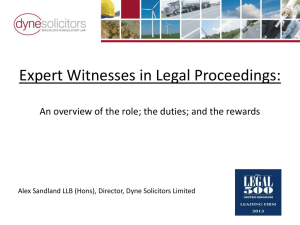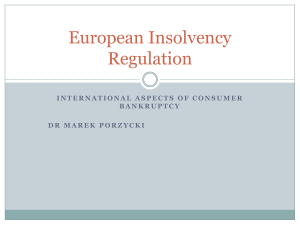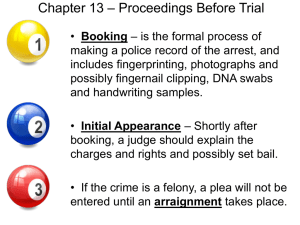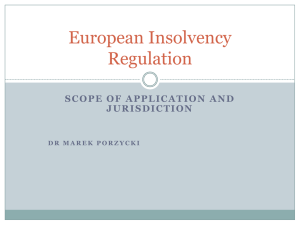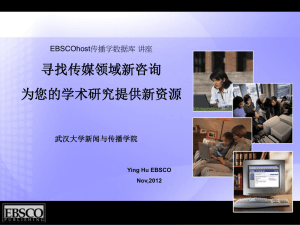Independent territorial proceedings
advertisement
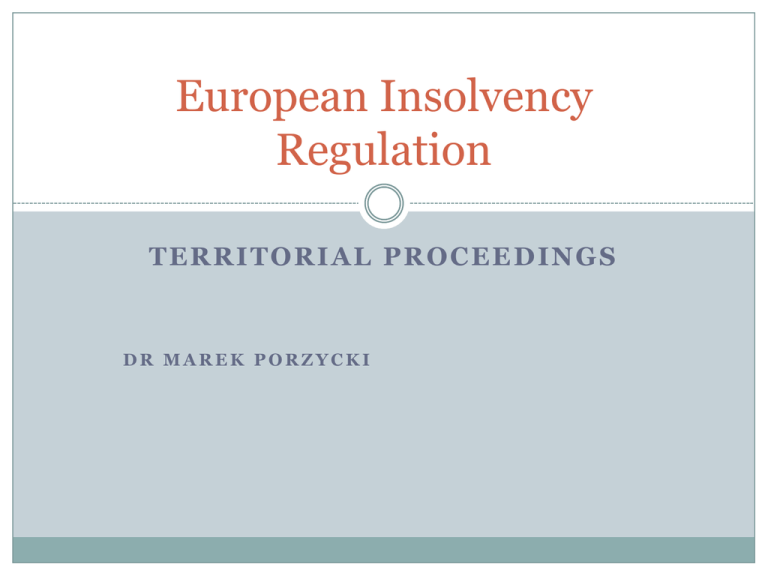
European Insolvency Regulation TERRITORIAL PROCEEDINGS DR MAREK PORZYCKI Territorial proceedings Secondary proceedings Independent territorial proceedings take place in parallel to main proceedings in another Member State (Art. 3(3) of the EIR ) must be winding-up proceedings (Art. 3(3) and Art. 27) take place without main proceedings being conducted in another Member State (Art. 3 (4) of the EIR) no limitations as to the type of proceedings Aims of territorial (secondary) proceedings protection of local interests „auxilliary” proceedings: - cases where the estate is too complex to administer as a unit - need to take into account the peculiarities of local law see recital 19 to the EIR, paragraphs 32-33 of the Virgos-Schmit Report Jurisdiction to open territorial proceedings the courts of a Member State where the debtor possesses an establishment (Art. 3(2) of the EIR) definition of „establishment” – any place of operations where the debtor carries out a non-transitory economic activity with human means and goods (Art. 2(h) of the EIR) mere existence of assets in a Member State is not enough for this State’s jurisdiction (cf. Art. 382(2) of the Polish BRL for non-EU cases) „establishment” requires a structure consisting of a minimum level of organisation and a degree of stability necessary for the purpose of pursuing an economic activity (ECJ in Interedil) cases of a „race to the court” (see Eurofood) - can COMI be requalified as establishment („second prize”)? Grounds to open territorial proceedings secondary proceedings: the mere fact of main proceedings pending substitutes for any actual examination of insolvency for the aims of the opening of secondary proceedings (Art. 27) - presumption of insolvency or duty to open secondary proceedings? duty to open if other conditions are fulfilled („automatism of opening”, Eröffnungsautomatik)? See Opinion of Advocate General J. Kokott of 24 May 2012 in Case C-116/11, Bank Handlowy and Adamiak. subject to other conditions of the law of the State of the opening of secondary proceedings (valid request, sufficiency of assets, applicability of national insolvency law to the debtor in question etc.) Grounds to open territorial proceedings continued independent territorial proceedings: all requirements of the applicable national law (Art. 4(2)), including the examination of insolvency subject to Art. 3(4): - main insolvency proceedings cannot be opened because of conditions of the law of the State where the debtor’s COMI is situated; or - territorial proceedings are requested by a local creditor or a creditor whose claim arises from the operation of the establishment in question protection of local interests Right to request opening of territorial proceedings secondary proceedings (Art. 29 of the EIR) - liquidator in the main proceedings - any other person or authority empowered to request the opening of insolvency proceedings under national law - a misunderstanding under Polish law: … empowered to request the opening of insolvency proceedings (Art. 20 of the Polish BRL) or secondary insolvency proceedings in non-EU cases (Art. 407 of the BRL)? – SN (Supreme Court) judgment of 20.1.2010, III CZP 115/09 independent territorial proceedings - persons entitled to request the opening of proceedings under the law of the Member State concerned (Article 4 of the EIR), subject to Art. 3 (4)(b) creditor from the Member State concerned; creditor whose claim arises from the operation of the establishment concerned Effects and recognition of territorial proceedings territoriality: effects limited to the assets located in the Member State where the proceedings are opened (Art. 3(2); Art. 17(2) of the EIR) automatic recognition (Art. 16(1) of the EIR) upholds the position of liquidator in the territorial proceedings right of the liquidator to pursue assets moved to another Member State; right to bring actions to set aside (avoidance actions) – Art. 18 (2) of the EIR Winding-up proceedings Secondary proceedings must be winding-up proceedings listed in Annex B to the EIR! (Art. 3(3), Art. 27 of the EIR) reason: practical difficulties in coordinating two different sets of restructuring proceedings criticism: inflexible solutions, may hamper restructuring efforts, in particular if a substantial part of debtor’s assets is included in the secondary proceedings reform proposals: secondary restructuring proceedings are likely to be allowed soon Subsequent opening of main proceedings independent territorial proceedings become secondary proceedings (recital 17) limitations to application of provisions on secondary proceedings (Art. 36) conversion into winding-up proceedings – depending on request of the liquidator and on interests of the creditors in the main proceedings (Art. 37) Coordination between main and secondary proceedings Art. 31 of the EIR – cooperation between liquidators no explicit provision on cooperation between courts cf. Art. 25 – 27 of the UNICTRAL Model Law on Cross-Border Insolvency in practice: a specific agreement (‘protocol for cooperation’) can be concluded to establish rules on cooperation between courts and/or liquidators in a particular case a „soft law” initiative - European Cooperation and Communication Guidelines for Cross-Border Insolvency (CoCo Guidelines) Creditor satisfaction in main and secondary proceedings right to lodge claims in both proceedings (Art. 32(1)) cross-submission of claims by liquidators in both proceedings (Art. 32(2)) right of the liquidator to participate in other proceedings as a creditor (Art. 32(2)) partial coordination of payouts to creditors – every creditor to keep amounts obtained in one set of proceedings but it is taken into account in the other proceedings (Art. 20(2), see also recital 21) – „hotchpot rule” or equalization of dividends assets remaining in the secondary proceedings transfer to the liquidator in main proceedings (Art. 35) Case of a solvent debtor main proceedings (listed in Annex A) against a solvent debtor, aimed at restructuring examples: French sauvegarde, but also in some cases German Insolvenzverfahren secondary proceedings as winding-up proceedings listed in Annex B (Art. 3(3) and Art. 27), opened automatically upon request but see Opinion of Advocate General J. Kokott of 24 May 2012 in Case C116/11, Bank Handlowy and Adamiak cases where an „establishment” includes the major part or all of the debtor’s estate controversial rulings on COMI after Eurofood see case study in one of the next courses Restructuring in secondary proceedings? stay of liquidation under Art. 33 of the EIR closure by a rescue plan, a composition or a comparable measure under Art. 34 - restrictions of the possibility to adopt a rescue plan - scope of the rescue plan Polish law: conversion into reorganization bankruptcy (upadłość układowa)? see Annexes A and B Additional reading - S. Riedemann in: K. Pannen (ed.), European Insolvency Regulation, De Gruyter Berlin 2007, p. 60-66 (commentary on Art. 2(h)) - B. Wessels. M. Virgos, European Cooperation and Communication Guidelines for Cross-Border Insolvency , July 2007 (CoCo Guidelines): http://www.insol.org/INSOLfaculty/pdfs/BasicReading/Session%205/E uropean%20Communication%20and%20Cooperation%20Guidelines%20 for%20Cross-border%20Insolvency%20.pdf -M. Porzycki, Secondary Insolvency Proceedings against a Solvent Debtor: A Polish Case Highlights Weak Points of the European Insolvency Regulation, International Corporate Rescue 2010, Volume 7, Issue 2, p. 118 In Polish: P. Filipiak in: F. Zedler, P. Filipiak, A. Hrycaj, Komentarz do rozporządzenia Rady (WE) Europejskie prawo upadłościowe. Komentarz, Wolters Kluwer 2011,commentary to Articles 27-37 of the EIR

